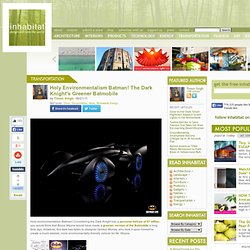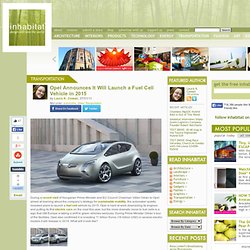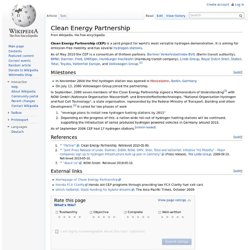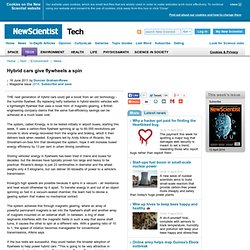

Car Sharing Autopia. San Diego is launching North America’s first large-scale all-electric car sharing fleet with itty-bitty EVs people can grab quickly, easily and spontaneously.

Daimler subsidiary car2go will roll out 300 Smart ForTwo Electric Drives by the end of the year. Subscribers will simply grab a car from designated spots around the city. That’s a contrast to Zipcar, which requires users to pick up and return vehicles from the same location. The goal, says car2go, is to make car sharing easier, faster and more practical. World's Oldest Hybrid - Porsche Semper Vivus. Think hybrid vehicles have only been around a couple of decades?

The Porsche Semper Vivus, developed over a century ago in the year 1900 proves otherwise. A beautifully crafted copy of the original Semper Vivus hybrid drove into the New York Auto Show last week and parked next to the new 2012 Panamera S Hybrid. Hit the jump to see a video of it in action! Ferdinand Porsche built the Semper Vivus hybrid at the turn of the last century, making it one of the first hybrid cars ever made. Holy Environmentalism Batman! Holy environmentalism Batman!

Considering the Dark Knight has a personal fortune of $7 billion, you would think that Bruce Wayne would have made a greener version of the Batmobile a long time ago. However, this task has fallen to designer Gordon Murray, who took it upon himself to create a much sleeker, more environmentally-friendly vehicle for Mr. Wayne. Opel Announces It Will Launch a Fuel Cell Vehicle in 2015. During a recent visit of Hungarian Prime Minister and EU Council Chairman Viktor Orbán to Opel aimed at learning about the company’s strategy for sustainable mobility, the automaker quietly revealed plans to launch a fuel cell vehicle by 2015.

Opel is hard at work downsizing its engines and putting its first electric cars on the road this year, but the more dramatic move to fuel cells is a sign that GM Europe is taking a shift to green vehicles seriously. During Prime Minister Orbán’s tour of the facilities, Opel also confirmed it is investing 11 billion Euros (16 billion USD) in several electric models it will release in 2014. What will it look like? We’re hoping the Opel fuel cell is modeled after the company’s recent Flextreme concept car, pictured here. Uno 3 Electric Scooter. BPG Motors just announced that their crazy transforming Uno 3 scooter is now available for pre-order!

The high-powered electric di-cycle can be ridden on two or three wheels, and it’s compact enough to ride right into your elevator or into your apartment. New Liquid Flow Batteries for EV's. A team of researchers at MIT set out to “reinvent the rechargeable battery” and succeeded by creating a liquid-flow battery, suitable for electric vehicles that can be recharged as quickly as simply pumping gas and could halve the cost of current EV batteries.
The new batteries involve a semi-solid, liquid electrolyte material which holds suspended positive and negative electrodes that provide needed electricity. When all the energy has been zapped out of the amorphous material, you can simply remove it from the battery — recharge it for future use — and replace it with fully charged goo. The team at MIT envisions this happening in much the same way — and about the same amount of time — that we’re all used to pumping gas. This kind of liquid flow battery is not new, but prior research teams were not able to find a material that had high enough energy density to make the batteries plausible. CEP Hydrogen Fuel Stations. As of May 2010 the CEP is a consortium of thirteen partners: Berliner Verkehrsbetriebe BVG (Berlin transit authority), BMW , Daimler , Ford , GM / Opel , Hamburger Hochbahn (Hamburg transit company), Linde Group , Royal Dutch Shell , Statoil , Total , Toyota , Vattenfall Europe , and Volkswagen Group . [ 1 ] [ edit ] Milestones In November 2004 the first hydrogen station was opened in Messedamn , Berlin , Germany .

On July 13, 2006 Volkswagen Group joined the partnership. In September, 2009 seven members of the Clean Energy Partnership signed a Memorandum of Understanding [ 2 ] with NOW GmbH (Nationale Organisation Wasserstoff- und Brennstoffzellentechnologie, "National Organisation Hydrogen and Fuel Cell Technology", a state organisation. represented by the Federal Ministry of Transport, Building and Urban Development. [ 3 ] It called for two phases of work "leverage plans to install new hydrogen fuelling stations by 2011" News - Clean Energy Partnership. Hannover Messe 2014: German premiere of Honda’s FCEV Concept at the CEP booth German premiere of Honda’s FCEV Concept at the Hannover Messe 2014 (April 7 - 12): The concept vehicle is on display at the Clean Energy Partnership (CEP) demonstration project booth in hall 27, booth B73.

Visitors can also experience the pleasure of driving a fuel cell car for themselves at the Ride + Drive Area in fuel cell vehicles from Daimler, Honda, Hyundai, Opel, Toyota and Volkswagen.:: more The Power-full Neighbours: CEP´s new onlinefilm It is night, a great storm comes. The wind turbines are turning fast - electricity production is in full swing! 'all-electric highway' Readers of a certain age may remember the 1982 hit "Electric Avenue" by Eddy Grant.

Now, Stanford University is putting its own spin on the concept. The school says it's developing a technology that would allow electric-drive vehicles to be recharged as they're being driven down the road. The system involves magnetic energy being sent between metal coils placed in the road a few feet apart. The process, called "magnetic resonance coupling," involves tuning the road coils and a coil at the bottom of a car to the same natural frequency, so that, when the road coils are charged with an electric current, they send electricity to the coil in the car, which then recharges a battery. Ultimately, Stanford researchers say they can develop what's essentially an electric highway that one of the researchers said may give an EV a higher charge after driving than before the trip started. Car Bodies That Double as Batteries. Source: Imperial College London It may look like any other car, but the battery-powered vehicle in Emile Greenhalgh’s laboratory could just steer us towards the future of electric transportation.

One of the most salient issues in electric car development is that of range: typical batteries only provide enough power for 100 miles of driving. The technology that Dr. Greenhalgh has been developing at Imperial College London tackles this obstacle not by enlarging the battery, but by storing electricity in the body components of the car – the roof, the hood, the trunk lid can all be used to help propel the car forward over greater distances. Hybrid cars give flywheels a spin. THE next generation of hybrid cars could get a boost from an old technology - the humble flywheel.

By replacing hefty batteries in hybrid electric vehicles with a lightweight flywheel that uses a novel form of magnetic gearing, a British engineering company claims that the same fuel-efficiency savings can be achieved at a much lower cost. The system, called Kinergy, is to be tested initially in airport buses, starting this week. It uses a carbon-fibre flywheel spinning at up to 60,000 revolutions per minute to store energy recovered from the engine and braking, which it then delivers back when needed. Fast adoption of electric cars. As more and more electrified vehicles hit the floors of car dealerships, conventional wisdom has it that the market won’t get moving without richer incentives and dense battery-charging networks. Yet our research on demand for electric cars in very large urban areas shows that plug-in hybrid electric vehicles and battery-only electric vehicles could account for 16 percent of overall new-car sales in New York, 9 percent in Paris, and 5 percent in Shanghai by 2015.
That’s true even with today’s financial incentives and limited public charging facilities. It’s not surprising that the market may take root in big cities: nowhere is the need for cleaner air and reduced carbon dioxide emissions more pressing, and nowhere else can you expect to find as many green-minded early adopters who will welcome a clean vehicle that takes them the short distances they need to go on one charge.
GE Builds EV Charging Solar Carport. GE partnered with Inovateus Solar recently to build an EV-charging solar carport in Plainville, Connecticut. The structure was unveiled yesterday with Connecticut Governor Dannel Malloy and GE Energy Industrial Solutions CEO Luis Ramírez on hand. The solar carport can charge 13 electric vehicles per day in addition to powering its own lighting, and produces enough energy to power 20 homes per year. Eos 'refillable' vehicle battery. MIT students develop liquid fuel for electric cars. A group of Massachusetts Institute of Technology students may have come up with the perfect solution to our electric vehicle charging woes.
Instead of relying on lithium or nickel, the new battery design stores its electrons in semi-solid flow cells. Charged particles are suspended in an electrolyte solution and pumped between compartments used for storing or releasing energy. The tech supposedly makes the batteries up to ten times more efficient than their traditional counterparts, and even more importantly, the new tech is cheaper to produce. Composite Structural Power Storage.